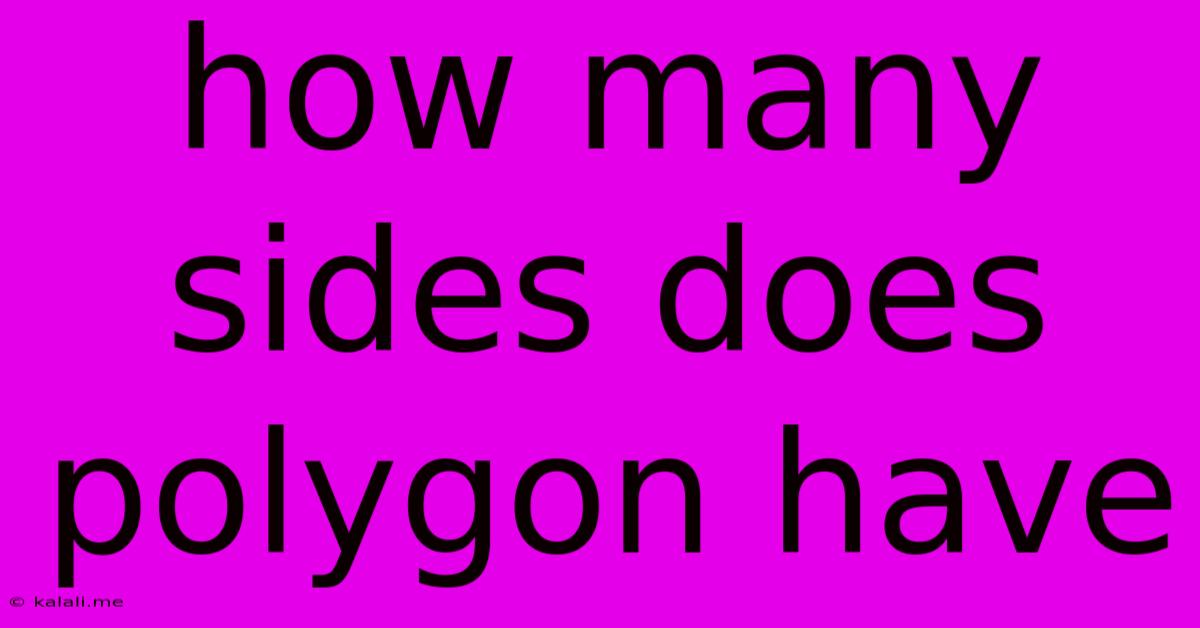How Many Sides Does Polygon Have
Kalali
May 22, 2025 · 3 min read

Table of Contents
How Many Sides Does a Polygon Have? A Comprehensive Guide
Meta Description: Learn all about polygons and their defining characteristic: the number of sides! This guide explores different types of polygons, from triangles to nonagons and beyond, explaining their properties and how they're classified.
Polygons are fundamental shapes in geometry, and understanding their properties is crucial for various mathematical applications. But the most basic question, often the first hurdle for beginners, is: how many sides does a polygon have? The answer, as you'll soon discover, isn't a single number but a range determined by the polygon's classification.
Defining a Polygon
Before diving into the number of sides, let's define what a polygon actually is. A polygon is a closed, two-dimensional shape formed by connecting a set of straight line segments. These segments are called the sides of the polygon, and the points where the sides meet are called vertices or corners. Crucially, a polygon must be closed; an open line segment is not a polygon.
Types of Polygons Based on the Number of Sides
The number of sides directly determines the type of polygon. Here's a breakdown of common polygon types:
- 3 Sides: Triangle (equilateral, isosceles, scalene) Triangles are the simplest polygons and form the basis for many geometric constructions.
- 4 Sides: Quadrilateral (square, rectangle, rhombus, parallelogram, trapezoid, kite) Quadrilaterals offer a wider variety of shapes with different properties relating to angles and side lengths.
- 5 Sides: Pentagon (regular pentagon, irregular pentagon) Pentagons are often found in nature and architecture.
- 6 Sides: Hexagon (regular hexagon, irregular hexagon) Hexagons are notably used in honeycomb structures.
- 7 Sides: Heptagon (or septagon)
- 8 Sides: Octagon Octagons are frequently seen in stop signs.
- 9 Sides: Nonagon (or enneagon)
- 10 Sides: Decagon
- 11 Sides: Hendecagon (or undecagon)
- 12 Sides: Dodecagon
This list continues, with polygons having 13 sides (tridecagon), 14 sides (tetradecagon), and so on. There's no theoretical upper limit to the number of sides a polygon can have. Polygons with a large number of sides often appear almost circular.
Regular vs. Irregular Polygons
It's important to distinguish between regular and irregular polygons. A regular polygon has all its sides of equal length and all its interior angles equal in measure. An irregular polygon, on the other hand, has sides and angles of varying lengths and measures. For example, a square is a regular quadrilateral, while a trapezoid is an irregular quadrilateral.
Polygons and Their Applications
Polygons are far more than just abstract geometric concepts. They play a significant role in various fields:
- Architecture and Engineering: Polygons are fundamental to building design, creating stable and aesthetically pleasing structures.
- Computer Graphics: Polygons are the building blocks of 3D models and computer-generated imagery.
- Tessellations: The ability of certain polygons to tile a surface without gaps forms the basis of tessellations, seen in art and nature.
- Nature: Many natural formations, from crystals to honeycombs, exhibit polygonal structures.
Understanding the properties of polygons, beginning with the simple question of "how many sides?", is a foundational step in appreciating their wide-ranging applications and the beauty of geometry. From the humble triangle to the complex dodecagon and beyond, the world of polygons is rich in mathematical beauty and practical utility.
Latest Posts
Latest Posts
-
How Long Can A Refrigerator Stay Cold Without Power
May 22, 2025
-
Symbols For Elements Earth Air Fire Water
May 22, 2025
-
Why Do I Get Electric Shocks
May 22, 2025
-
What Is The Constant Term In Binomial Expansion
May 22, 2025
-
How Old Was Jesus When The Magi Came
May 22, 2025
Related Post
Thank you for visiting our website which covers about How Many Sides Does Polygon Have . We hope the information provided has been useful to you. Feel free to contact us if you have any questions or need further assistance. See you next time and don't miss to bookmark.